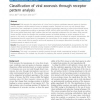Free Online Productivity Tools
i2Speak
i2Symbol
i2OCR
iTex2Img
iWeb2Print
iWeb2Shot
i2Type
iPdf2Split
iPdf2Merge
i2Bopomofo
i2Arabic
i2Style
i2Image
i2PDF
iLatex2Rtf
Sci2ools
BMCBI
2011
2011
Classification of viral zoonosis through receptor pattern analysis
Background: Viral zoonosis, the transmission of a virus from its primary vertebrate reservoir species to humans, requires ubiquitous cellular proteins known as receptor proteins. Zoonosis can occur not only through direct transmission from vertebrates to humans, but also through intermediate reservoirs or other environmental factors. Viruses can be categorized according to genotype (ssDNA, dsDNA, ssRNA and dsRNA viruses). Among them, the RNA viruses exhibit particularly high mutation rates and are especially problematic for this reason. Most zoonotic viruses are RNA viruses that change their envelope proteins to facilitate binding to various receptors of host species. In this study, we sought to predict zoonotic propensity through the analysis of receptor characteristics. We hypothesized that the major barrier to interspecies virus transmission is that receptor sequences vary among species–in other words, that the specific amino acid sequence of the receptor determines the ability o...
| Added | 12 May 2011 |
| Updated | 12 May 2011 |
| Type | Journal |
| Year | 2011 |
| Where | BMCBI |
| Authors | Se-Eun Bae, Hyeon Seok Son |
Comments (0)

